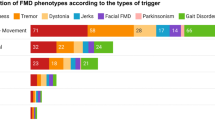Abstract
Background
Functional gait disorders (FGDs) are relatively common in patients presenting for evaluation of a functional movement disorder (FMD). The diagnosis and classification of FGDs is complex because patients may have a primary FGD or a FMD interfering with gait.
Methods
We performed a detailed evaluation of clinical information and video recordings of gait in patients diagnosed with FMDs.
Results
We studied a total of 153 patients with FMDs, 68% females, with a mean age at onset of 36.4 years. A primary FGD was observed in 39.2% of patients; among these patients, 13 (8.5%) had an isolated FGD (a gait disorder without other FMDs). FMDs presented in 34% of patients with otherwise normal gait. Tremor was the most common FMD appearing during gait, but dystonia was the most common FMD interfering with gait. Patients with FGD had a higher frequency of slow-hesitant gait, astasia-abasia, bouncing, wide-based gait and scissoring compared with patients with FMDs occurring during gait. Bouncing gait with knee buckling was more frequently observed in patients with isolated FGD (P = 0.017). Patients with FGDs had a trend for higher frequency of wheelchair dependency (P = 0.073) than those with FMDs interfering with gait.
Conclusions
Abnormal gait may be observed as a primary FGD or in patients with other FMDs appearing during gait; both conditions are common and may cause disability.
Similar content being viewed by others
References
Jankovic J (2015) Gait disorders. Neurol Clin 33:249–268
Fung VSC (2016) Functional gait disorder. Handb Clin Neurol 139:263–270
Edwards M (2018) Functional (psychogenic) gait disorder: diagnosis and management. Handb Clin Neurol 159:417–423
Baizabal-Carvallo JF, Hallett M, Jankovic J (2019) Pathogenesis and pathophysiology of functional (psychogenic) movement disorders. Neurobiol Dis 127:32–44
Asadi-Pooya AA (2016) Psychogenic nonepileptic seizures are predominantly seen in women: potential neurobiological reasons. Neurol Sci 37(6):851–855
Keane JR (1989) Hysterical gait disorders: 60 cases. Neurology 39:586–589
Hayes MW, Graham S, Heldorf P, de Moore G, Morris JG (1999) A video review of the diagnosis of psychogenic gait: appendix and commentary. Mov Disord 14:914–921
Laub HN, Dwivedi AK, Revilla FJ, Duker AP, Pecina-Jacob C, Espay AJ (2015) Diagnostic performance of the “huffing and puffing” sign in psychogenic (functional) movement disorders. Mov Disord Clin Pract 2:29–32
Jankovic J (2011) Diagnosis and treatment of psychogenic parkinsonism. J Neurol Neurosug Psychiatry 82:1300–1303
Thomson AP, Sills JA (1988) Diagnosis of functional illness presenting with gait disorder. Arch Dis Child 63:148–153
Thenganatt MA, Jankovic J (2019) Psychogenic (functional) movement disorders. Continuum (Minneap Minn) 25:1121–1140
Dallocchio C, Matinella A, Arbasino C, Arno’ N, Glorioso M, Sciarretta M, Braga M, Tinazzi M (2019) Movement disorders in emergency settings: a prospective study. Neurol Sci 40(1):133–138
Fahn S, Williams DT (1998) Psychogenic dystonia. Adv Neurol 50:431–455
Gupta A, Lang AE (2009) Psychogenic movement disorders. Curr Opin Neurol 22:430–436
Thenganatt MA, Jankovic J (2015) Psychogenic movement disorders. Neurol Clin 33:205–224
Lempert T, Brandt T, Dieterich M, Huppert D (1991) How to identify psychogenic disorders of stance and gait. A video study in 37 patients. J Neurol 238:140–146
Baik JS, Lang AE (2007) Gait abnormalities in psychogenic movement disorders. Mov Disord 22:395–399
Daum C, Hubschmid M, Aybek S (2014) The value of ‘positive’ clinical signs for weakness, sensory and gait disorders in conversion disorder: a systematic and narrative review. J Neurol Neurosurg Psychiatry 85:180–190
Daum C, Gheorghita F, Spatola M, Stojanova V, Medlin F, Vingerhoets F, Berney A, Gholam-Rezaee M, Maccaferri GE, Hubschmid M, Aybek S (2015) Interobserver agreement and validity of bedside ‘positive signs’ for functional weakness, sensory and gait disorders in conversion disorder: a pilot study. J Neurol Neurosurg Psychiatry 86:425–430
Jacob AE, Kaelin DL, Roach AR, Ziegler CH, LaFaver K (2018) Motor retraining (MoRe) for functional movement disorders: outcomes from a 1-week multidisciplinary rehabilitation program. PM R 10:1164–1172
Nielsen G, Stone J, Matthews A, Brown M, Sparkes C, Farmer R, Masterton L, Duncan L, Winters A, Daniell L, Lumsden C, Carson A, David AS, Edwards M (2015) Physiotherapy for functional motor disorders: a consensus recommendation. J Neurol Neurosurg Psychiatry 86:1113–1119
Jordbru AA, Smedstad LM, Klungsøyr O, Martinsen EW (2014) Psychogenic gait disorder: a randomized controlled trial of physical rehabilitation with one-year follow-up. J Rehabil Med 46:181–187
Jordbru AA, Smedstad LM, Moen VP, Martinsen EW (2012) Identifying patterns of psychogenic gait by video-recording. J Rehabil Med 44:31–35
Baizabal-Carvallo JF, Jankovic J (2017) Examiner maneuvers in functional (psychogenic) movement disorders. J Neurol Neurosurg Psychiatry 88:453–455
Kenney C, Diamond A, Mejia N, Davidson A, Hunter C, Jankovic J (2007) Distinguishing psychogenic and essential tremor. J Neurol Sci 263:94–99
Author information
Authors and Affiliations
Contributions
Dr. Baizabal-Carvallo gathered the data, made the statistical analysis, conceptualized, and wrote the first draft of the manuscript. Dr. Alonso-Juarez evaluated the data and reviewed the manuscript. Dr. Jankovic gathered the data, conceptualized, and reviewed the manuscript.
Corresponding author
Ethics declarations
Patients provided signed written informed consent, approved by the Baylor College of Medicine Institutional Review Board for Human Research, providing permission for videotaping and publishing the case and video in a scientific journal.
Conflict of interest
The authors declare that they have no conflict of interest.
Additional information
Publisher’s note
Springer Nature remains neutral with regard to jurisdictional claims in published maps and institutional affiliations.
Electronic supplementary material
ESM 1
(DOCX 14 kb)
Video 1
This is a 62-year-old man with severe astasia-abasia; he needs to hold on to the wall to walk. (AVI 93591 kb)
Video 2
This is a 66-year-old man with functional parkinsonism and very slow, hesitant gait. (AVI 91739 kb)
Video 3
This 20-year-old patient has bouncing gait with knee buckling, he uses a cane to stabilize his gait. (AVI 40870 kb)
Video 4
This is a 16-year old girl with left lower-limb fixed dystonia, she needs crutches to walk; after a correction maneuver the patient is able to walk normally. (AVI 76923 kb)
Rights and permissions
About this article
Cite this article
Baizabal-Carvallo, J.F., Alonso-Juarez, M. & Jankovic, J. Functional gait disorders, clinical phenomenology, and classification. Neurol Sci 41, 911–915 (2020). https://doi.org/10.1007/s10072-019-04185-8
Received:
Accepted:
Published:
Issue Date:
DOI: https://doi.org/10.1007/s10072-019-04185-8




